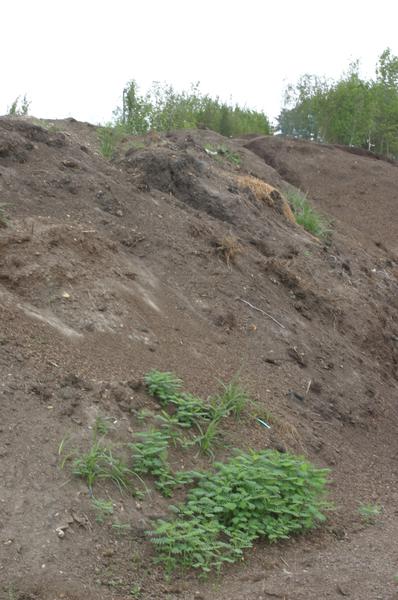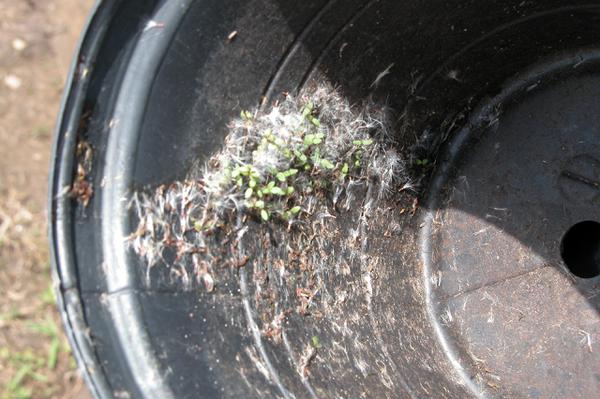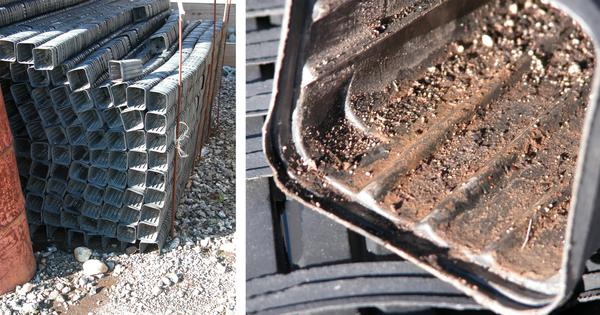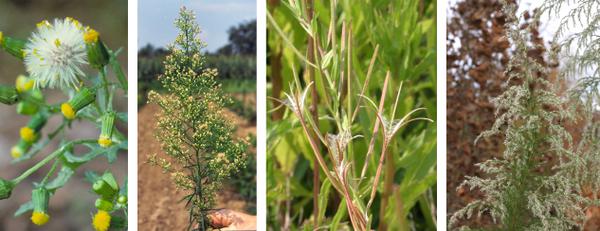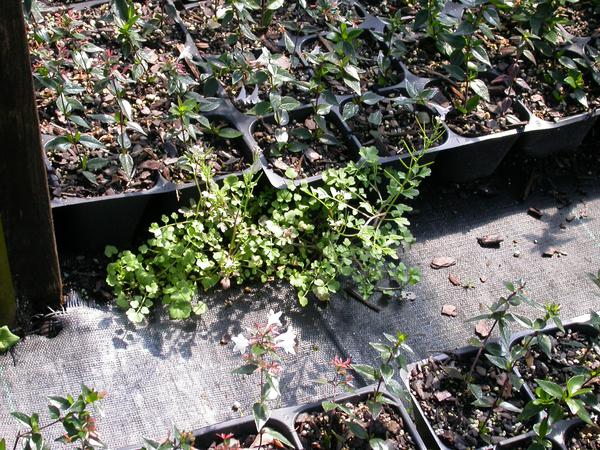Weed control in the production of woody nursery stock relies heavily upon the use of broad spectrum preemergence herbicides. These herbicides effectively control most weeds if applied before weed seeds germinate. However, all too often rooted cuttings or liners arrive at the nursery already containing weeds (Figure 1), sometimes introducing “new” weeds from other regions (Neal and Williams 1998). In this way, growers start the production cycle with emerged weeds that are not controlled by preemergence herbicide treatments, and introduce new weeds into their nursery that may not be controlled by existing management programs. To prevent such events, liner producers must maintain rigorous and effective weed management programs. Sanitation, hand weeding, and judicious use of herbicides must be integrated into a comprehensive weed management program.
Sanitation
Currently, no preemergence herbicides are labeled for use on unrooted cuttings, and few herbicides are labeled for use on liners. Consequently, weed management programs in propagation must rely upon sanitation, such as:
- preventing the introduction of weed propagules
- detecting weeds early and removing them before they produce seed
- controlling weeds around propagation beds.
Determining the source(s) of weed seed in a nursery may not be simple. Potential sources may include potting substrates, weeds growing near production space, and the pots themselves.
Potting substrates such as pine bark, peat moss, and perlite are generally free of weed seeds. However, when such materials are stockpiled, either at the nursery or at the substrate supplier’s facility, many weeds can be introduced. The presence of weeds in or near substrate piles will provide the opportunity for weed seed introduction via:
- wind (for weeds such as groundsel, horseweed, or dogfennel)
- physical dispersal (for weeds such as bittercress or oxalis)
- encroachment by rhizomatous and stoloniferous weeds (for weeds such as bermudagrass or mugwort).
Potting substrates need to be stored and mixed in areas that reduce the potential for weed seed contamination. The preferred storage area is a concrete slab. Never use recycled substrates in propagation or liner production (Figure 2).
Use New or Clean Containers
Recycling pots and flats can introduce weeds (Figure 3). Bachman and Whitwell (1995) demonstrated that bittercress infestations could be reduced six-fold simply by washing pots and flats with high-pressure water. Similarly, weeds should be controlled around pot storage areas to prevent the introduction of weeds into new and cleaned pots and flats.
Store pots and flats in weed-free areas, preferably on concrete or other hard surfaces (Figure 4). Nurseries in some regions steam-sterilize flats and pots before reuse. The practice is common in tobacco and forest tree nursery seedling production. Guidelines for steam sterilizing tobacco trays call for maintaining a temperature of 176°F for at least 30 minutes for disease control. Seeds of some weeds may require longer times or higher temperatures but, to date, exact temperatures have not been documented for killing seeds of most common nursery weeds.
Solarization has also been reported to reduce weeds in recycled containers. To treat pots, first wash them to remove debris and add moisture. Then wrap the pots loosely in clear plastic and leave them in the sun for a few days. On sunny, warm days heat can build up to levels high enough to kill many pathogens and weed seeds. Monitor temperatures under the plastic. Maintaining temperatures greater than 140°F for at least 1 hour is sufficient to kill seeds of many weed species (Prather et al. 2002). However, little research is available specifically with nursery weeds.
Many nursery weeds have effective means of dispersal. Bittercress, oxalis, mulberryweed, and spurges can disperse their seeds several feet from the parent plant (Figure 5). Seeds of many other common nursery weeds are spread by wind (such as: groundsel, horseweed, willowherb, and dogfennel) (Figure 6). And other weeds, such as pearlwort, liverwort, and eclipta, have seeds that are spread by splashing water (Figure 7). Therefore, it is imperative that the areas around propagation or liner production facilities be kept weed free.
Gravel or ground cloth are often used in propagation areas (Figure 8). Each has advantages and disadvantages. Gravel provides good drainage, but spilled substrate can “fill” the gravel, resulting in greater potential for weed growth. Compared to gravel, ground cloth can be more easily cleaned between crops, but spilled substrate on ground cloth can likewise provide an environment for weed growth (Figure 9 and Figure 10).
Using Herbicides in and Around Covered Structures
Within covered greenhouse-like structures, crop injury from herbicide volatilization is likely. Consequently, no residual herbicides are labeled for application to containers within such structures. In addition, only three residual herbicides are labeled for preemergence control of weeds in greenhouses and greenhouse-like structures. Those three are: sodium metaborate + sodium chlorate (BareSpot Monobor-Chlorate), flumioxazin (SureGuard), and indaziflam (Marengo). BareSpot may be used to kill existing vegetation and prevent weed growth in the ground within greenhouses. Do not use BareSpot in crop pots. SureGuard or Marengo may be applied to the gravel or ground under benches, around the foundation, or to the ground before crops are placed in the house. The house should be empty during treatment. Do not move plants into the greenhouse for at least 24 hours after SureGuard treatment. Although Marengo and SureGuard can be applied to certain woody container crops outside of the greenhouse, they are not labeled for use in the containers in the covered house.
Emerged weeds in greenhouses may be controlled with several postemergence herbicides including glyphosate (many trade names), glufosinate (Finale), diquat (Reward), and pelargonic acid (Scythe). These nonselective herbicides are labeled for controlling weeds under benches and along the foundations of enclosed structures, but care must be taken to prevent spray drift onto the crop. For weed control in covered structures, see Horticulture Information Leaflet Weed Control in Greenhouses and Covered Structures.
The areas outside greenhouses should be kept weed free to reduce the spread of weeds into the crops (Figure 11). The ground should be covered with plastic and geotextile (ground cloth) or with gravel. Preemergence herbicides may be used to prevent weed growth in gravel and the seams of geotextiles. To ensure crop safety, use only herbicides labeled for use in nursery crops. Never use soil sterilant-type herbicides such as imazapyr (Arsenal), sulfometuron (Oust), or prometon (Pramitol) in or around nurseries. The risk of crop injury is too great.
Of the many herbicides labeled for use in nursery crops, Smith et al. (1997) reported that prodiamine (Barricade) controlled bittercress in gravel areas. SureGuard or Marengo have also provided good residual weed control in gravel. Preemergence herbicides typically provide 10 to 12 weeks of residual weed control. Which should you use? That depends on the predominant weeds in your nursery. All three control spurge. SureGuard controls most broadleaf weeds, but Marengo is more effective on eclipta. Consider crop safety as well. In areas where tender herbaceous crops are produced, it is advisable to utilize Barricade +/- isoxaben (Gallery). Avoid SureGuard and Marengo, which have a higher potential to injure tender herbaceous plants through accidental exposure (by splashing, drift, or movement in surface water). To avoid the movement of spray drift into greenhouses, make sure exhaust fans are off and vents are closed before spraying herbicides near greenhouses.
Research: Herbicide Effects on Rooting of Cuttings
Previous work has shown that preemergence herbicides may be used in propagation beds—but it has also shown the potential for crop injury. Several studies have shown that Surflan (oryzalin) can reduce the percentage of rooting, the number of roots per cutting, and the quality of rooting (Johnson and Meade 1986; Thetford and Gilliam 1991). This observation is logical considering that oryzalin’s mode of action is root growth inhibition. Other root-inhibiting herbicides such as Barricade also inhibited rooting of azalea (Rhododendron obtusum) cuttings (Cook and Neal 2001). Non-root-inhibiting herbicides were tested, too, such as oxadiazon (Ronstar) and several granular formulations containing oxyfluorfen. They did not reduce rooting percentages of a wide variety of woody nursery crops (Johnson and Meade 1986; Langmaid 1987; Thetford and Gilliam 1991, Cook and Neal 2001). In one recent study, flumioxazin (BroadStar) damaged nonrooted cuttings of several nursery crop species. Due to the risk of crop injury and the fact that these herbicides are not labeled for use on crops within covered structures, the use of residual herbicides is generally not recommended in propagation, with very few exceptions.
Herbicide Safety of Liners
In the production of liners, sanitation remains the first and foremost defense against weeds. But a few preemergence and postemergence herbicides are labeled for use in this battle. Five preemergence herbicides are specifically labeled for use on liners: Goal (oxyfluorfen), Ronstar (oxadiazon), Regal O-O (oxyfluorfen + oxadiazon), Devrinol (napropamide), and Pennant Magnum (S-metolachlor). Postemergence herbicides are available to control emerged grasses. Goal may be used to control some seedling broadleaf weeds in conifer liners, but it does not control larger established weeds and is best used as a preemergence treatment.
Goal is a preemergence and postemergence herbicide that is frequently used in conifer seedbeds, transplant beds, and liners. Goal injures most broadleaf and herbaceous ornamentals and, with a few exceptions, should not be used on those species. Spray applications of Goal should be applied before conifers break bud or at least six weeks after budbreak. Treatment during rapid spring growth will result in damage to the emerging foliage. When used according to manufacturer’s recommendations, Goal will control most annual grasses and broadleaf weeds. It will also control many emerged broadleaf weed seedlings.
Ronstar and Regal O-O are each formulated on granule carriers; consequently, they are safer on a wider range of woody ornamental species than sprayable formulations of the same active ingredients. Each of these products controls a relatively broad spectrum of weeds and is safe on a wide variety of nursery crops. Ronstar is probably the most widely used herbicide on woody liners because it has been on the market longer and is more widely available. Ronstar controls annual grasses and most broadleaf weeds from seed including bittercress and oxalis. Two notable exceptions are not well controlled by Ronstar—chickweed (Stellaria media) and spurge (Chamaesyce spp.). Combining Ronstar with oxyfluorfen in Regal O-O expands the spectrum of weeds controlled (compared to using Ronstar alone).
Devrinol is available as a sprayable formulation or a granule. Devrinol is effective on annual grasses and some broadleaf weeds, but it is weak on some important container weeds, such as bittercress (Cardamine spp.), woodsorrel (Oxalis spp.), and spurges (Chamaesyce spp.).
Pennant Magnum is currently only available as an emulsifiable concentrate (EC) formulation; this formulation can injure tender foliage if applied over liners within a few weeks after budbreak. Pennant Magnum controls annual grasses, annual sedges, and a few broadleaf weeds such as galinsoga (Galinsoga spp.). However, the most common use for Pennant Magnum in field liner or transplant beds is for preemergence suppression of yellow nutsedge (Cyperus esculentus) and annual sedges (Cyperus spp.) Pennant Magnum is not commonly used in container liner stock because it lacks efficacy on several common container weeds, including bittercress, spurge, and oxalis.
Apply preemergence herbicides after potting and reapply roughly every 90 days. Hand weed frequently to prevent escaped weeds from going to seed. To see which species are safely controlled by these herbicides on different crops, consult the product labels. But a summary of the label information is available from Weed Management in Nurseries, Landscapes, and Christmas Trees.
Postemergence weed control in liner beds is generally restricted to hand weeding with a few exceptions. Goal can be used to control many young broadleaf weed seedlings in conifers. Goal should not be applied over the top of broadleaf liners. Several selective postemergence grass herbicides are labeled for over-the-top applications in seedbeds or liners—sethoxydim (Segment), fluazifop-p-butyl (Fusilade II), and clethodim (Envoy). Segment controls summer annual grasses and perennial grasses. Fusilade II and Envoy are generally somewhat better on perennial grasses than Segment. Envoy controls annual bluegrass, whereas Fusilade II and Segment do not. In transplant beds or liners, any of these three grass herbicides may be used. However, check the Fusilade II label carefully for juniper and azalea variety restrictions.
Herbicide Safety During Grafting
Of special concern to many liner producers is whether preemergence herbicide programs may affect grafting success. In recent research at North Carolina State University, four common preemergence herbicides were each applied at the highest labeled rates at 6- to 8-week intervals over the growing season to six species of container-grown seedling rootstocks destined for winter bench grafting. The four herbicides were: Scotts OH2 (oxyfluorfen + pendimethalin), Snapshot TG (trifluralin + isoxaben), Ronstar, and BroadStar (granular flumioxazin). Dormant scions were bench-grafted to their respective rootstocks the following winter. Preemergence herbicide treatments had no effect on grafting success for any of the cultivars. Data indicate that these preemergence herbicides, labeled for use in container-grown nursery crops, can be used in accordance with label recommendations to control weeds in containerized rootstocks without affecting subsequent grafting success (LeBude et al. 2009).
Summary
In each step of propagation and liner production, sanitation remains the most important strategy for controlling weeds. You can prevent the introduction of weeds by controlling weeds around the propagation, production, and potting substrate and pot storage areas. You can also prevent the buildup of weed populations by hand weeding frequently before weeds can shed their seed. In addition, you can control weeds in walkways, in gravel pads, and in liner pots or beds by using preemergence herbicides judiciously. This will greatly reduce the amount of hand weeding that is necessary to produce quality, weed-free liners.
Literature Cited
Bachman, G. and T. Whitwell. 1995. Hairy bittercress seed production, dispersal, and control. Proc. So. Nursery Assoc. Res. Conf. 40:288-290.
Cook, J. C. and J. C. Neal. 2001. Effects of herbicides and application timing on rooting of azalea and Japanese holly cuttings. Proc. Southern Nursery Assoc. Res. Conf. 46:422-424.
Johnson, J. R. and J. A. Meade. 1986. Pre-emergent herbicide effect on the rooting of cuttings. Proc. Intern. Plant Prop. Soc. 36:567-570.
Langmaid, Marty. 1987. Herbicides used in propagation at Wight Nurseries. Proc. Intern. Plant Prop. Soc. 37:539-540.
LeBude, A.V., B. L. Upchurch, and J. Neal. 2009. Preemergence herbicide applications to six containerized woody ornamental rootstocks do not affect winter grafting success. J. Environ. Hort. 27:119–122.
Neal, J. C. and A. Williams. 1998. Eastern North Carolina nursery weed scouting program - 1997. Proc. Northeastern Weed Sci. Soc. 52:134.
Prather, T. S., J. J. Stapleton, S. B. Mallek, T. S. Ruiz, and C. L. Elmore. 2002. High temperature solarization for production of weed-free container soils and potting mixes. HortTechnology 12(4): 697-700.
Smith, R., T. Whitwell, and G. Legnani. 1997. Bittercress control in gravel beds with preemergence herbicides. Proc. Southern Nursery Assoc. Res. Conf. 42:82-85.
Thetford, M. and C. H. Gilliam. 1991. Herbicide use in propagation: effects on rooting and root growth of stem cuttings. J. Environ. Hort. 9(1):21-23.
Publication date: Dec. 15, 2016
AG-827
Recommendations for the use of agricultural chemicals are included in this publication as a convenience to the reader. The use of brand names and any mention or listing of commercial products or services in this publication does not imply endorsement by NC State University or N.C. A&T State University nor discrimination against similar products or services not mentioned. Individuals who use agricultural chemicals are responsible for ensuring that the intended use complies with current regulations and conforms to the product label. Be sure to obtain current information about usage regulations and examine a current product label before applying any chemical. For assistance, contact your local N.C. Cooperative Extension county center.
N.C. Cooperative Extension prohibits discrimination and harassment regardless of age, color, disability, family and marital status, gender identity, national origin, political beliefs, race, religion, sex (including pregnancy), sexual orientation and veteran status.


